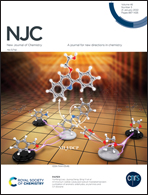Discovery of 3-chlorobenzyl-linked 1,9-diazaspiro[5.5]undecane derivatives, a lead for dengue virus type 2 infection†
Abstract
Dengue virus poses a serious worldwide health threat with up to 400 million infections occurring annually in over 100 countries. Currently, there are no specific therapeutics available, and the only licensed vaccine is used to mitigate the risk of hospitalization in immunologically naive individuals. In the current work, for the first time we are reporting dengue virus type 2 (DENV2) inhibitory activity in newly designed 3-chlorobenzyl-linked 1,9-diazaspiro[5.5]undecane derivatives. Compounds with substitutions featuring 2-methylbenzyl (SPO-6, EC50 = 11.43 ± 0.87 μM), 4-bromobenzyl (SPO-7, EC50 = 14.15 ± 0.50 μM), and 4-cyanobenzyl (SPO-13, EC50 = 20.77 ± 1.92 μM) groups and the antiviral drug ribavirin (IC50 = 50.9 ± 18 μM, J. Gen. Virol., 2006, 87, 1947–1952) were found to be potent against DENV2 in a cell-based assay. Docking calculations identified NS5-methyltransferase as the most probable target for this series of compounds. Molecular dynamics simulations of NS5-methyltransferase reproduced the experimental binding affinity findings by yielding ΔGbind values that predicted SPO-6 to possess the most favorable binding energy of −27.2 ± 3.9 kcal mol−1 compared with SPO-7, SPO-13 and ribavirin with −22.5 ± 4.7, −22.5 ± 4.6 and −20.0 ± 4.6 kcal mol−1, respectively. In addition, based on Lipinski's rule of five, SPO-6 was found to be non-toxic and possessed a better drug-likeness score (5.87) in comparison with the standard drug ribavirin (1.72).
![Graphical abstract: Discovery of 3-chlorobenzyl-linked 1,9-diazaspiro[5.5]undecane derivatives, a lead for dengue virus type 2 infection](/en/Image/Get?imageInfo.ImageType=GA&imageInfo.ImageIdentifier.ManuscriptID=D1NJ02453A&imageInfo.ImageIdentifier.Year=2022)


 Please wait while we load your content...
Please wait while we load your content...